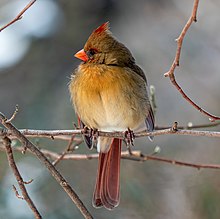
Back Rēadcardinal ANG كردينال شمالي Arabic الكاردينال الشمالى ARZ Cardinalis cardinalis AST Северен кардинал Bulgarian নর্দার্ন কার্ডিনাল Bengali/Bangla Cardinalis cardinalis Breton Cardenal vermell Catalan Cardinalis cardinalis CEB Kardinál červený Czech
| Northern cardinal | |
|---|---|

| |
| Male in New York, United States | |

| |
| Female in New York, United States | |
| Scientific classification | |
| Domain: | Eukaryota |
| Kingdom: | Animalia |
| Phylum: | Chordata |
| Class: | Aves |
| Order: | Passeriformes |
| Family: | Cardinalidae |
| Genus: | Cardinalis |
| Species: | C. cardinalis
|
| Binomial name | |
| Cardinalis cardinalis | |
| Subspecies | |
|
19 subspecies, see text | |

| |
| Approximate distribution map
Year-round
| |
| Synonyms | |
| |
The northern cardinal (Cardinalis cardinalis), known colloquially as the redbird, common cardinal, red cardinal, or just cardinal, is a bird in the genus Cardinalis. It can be found in southeastern Canada, through the eastern United States from Maine to Minnesota to Texas, New Mexico, southern Arizona, southern California, and south through Mexico, Belize, and Guatemala. It is also an introduced species in a few locations such as Bermuda and Hawaii. Its habitat includes woodlands, gardens, shrublands, and wetlands. It is the state bird of Illinois, Indiana, Kentucky, North Carolina, Ohio, Virginia, and West Virginia.
The northern cardinal is a mid-sized perching songbird with a body length of 21–23 cm (8.3–9.1 in) and a crest on the top of the head. The species expresses sexual dimorphism: Females are a reddish olive color, and have a gray mask around the beak, while males are a vibrant red color, and have a black mask on the face, as well as a larger crest. Juvenile cardinals do not have the distinctive red-orange beak seen in adult birds until they are almost fully mature. On hatching, their beaks are grayish-black and they do not become the trademark orange-red color until they acquire their final adult plumage in the fall.[2]
The northern cardinal is mainly granivorous, but also feeds on insects and fruit. The male behaves territorially, marking out his territory with song. During courtship, the male feeds seed to the female beak-to-beak. The northern cardinal's clutch typically contains three to four eggs, with two to four clutches produced each year. It was once prized as a pet, but its sale was banned in the United States by the Migratory Bird Treaty Act of 1918.
- ^ BirdLife International (2018). "Cardinalis cardinalis". IUCN Red List of Threatened Species. 2018: e.T22723819A132024136. doi:10.2305/IUCN.UK.2018-2.RLTS.T22723819A132024136.en. Retrieved 12 November 2021.
- ^ "Juvenile Cardinals (Identification Guide with Pictures)". Birdfact. Retrieved 2023-09-05.
© MMXXIII Rich X Search. We shall prevail. All rights reserved. Rich X Search
